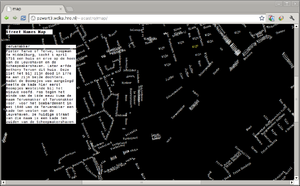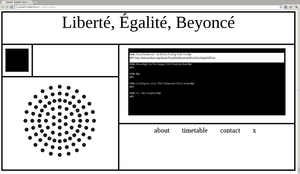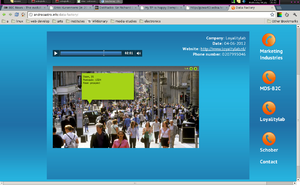User:Andre Castro/2.1/semniar-2012-10-10-summary
Project Proposal Drat
Description of my works in the past year
To begin with I started by writing on the performativity of code. Departing from Katherine Hayle's notion of code performativity and I went on looking at how does code perform us, how it has the capacity to change things, to similarly to performative speech-acts, but with a more direct and material effect.
Simultaneously I developed and online map of the streets of Rotterdam. This map - a striped-down version of the map of Rotterdam - displaying only the city street names against a black background, on the browser. By clicking on each street a request was made to the City of Rotterdam's Archive to provide information on that particular street's name origin. That information was then displayed alongside the map.
What seemed to create here was an interface to access city's archive through a different channel. By having the indexes of the archive - the street names - displayed on my screen I might see and ask for information on streets that I wouldn't be normally interested in knowing about. It opened up the possibility for a serendipitous navigation through the city name's history (archive).
The same serendiptous exploration made its way to the next project, the next work - Radio Liberté Egalité Beyoncé. RLEB was an online radio-station with a schedule composed of audio content fetched form Internet Archive. One-hour long cycles presented the listener with ten-minutes chunks of various sound materials, picked at chance, from within a specific categories, such as french talk-shows, hiphop, poetry readings, ambient music, etc. The design of website where RLEG was hosted presented a drawing of radio, with which the listener had to interact in order to get the radio playing.
The essay written alongside the RLEB began by tracing the archive's historical ties to power, functioning as a legitimator of power and knowledge. It also remarked on the ideology which underlies any archive, even folkloric archive such as Youtube. The ideology, can be best perceived through what is kept from entering the archive. However, in the essay I mention two important differences between a physical offline archive and a digital online one: the latter has the potential of a wider access, and also has the potential to let its item been taken by visitors, without impoverishing it. These difference result in an invitation for the individuals' appropriation and transformation of the archived material. When one of its items is taken and transformed, a new version of it appears, and a certain confusion emerges over its origin - which one is the original and which is fictitious? When remixed versions surface, they change the archive into a space of dialogue, and emergence of discourses, rather than a site aimed at legitimizing power and knowledge. The essay goes on mentioning artistic projects that try to address and remix large chunks of online archives, which only can be accomplished by the intervention of computer code. Curiously in these cases code is put to perform in order to bring a more humane sensibility (or intelligibility) to the archive. But that also demonstrates that code can perform quite beyond the reach of a single human.
Data Factory looked at direct marking companies' acquisition of consumers data, with the aim to target individual consumers with products which they might be more inclined to buy. It consisted of a small archive of recordings from phone-calls made to such companies in which I tried to sell them the of their business main ingredient - consumer data - being the consumer here only myself. Through the reactions to this simple short-circuit the ideology behind such business model became more apparent. The calls were gathered together in a website, with a certain corporate style, in which they could be listened to them, joined by pictures illustrating or ridiculing what was being said.
In the essay The Work of Audiences revolved around Dallas Smythe's concept of the work of audiences. In his view audiences have the job of creating demand for advertised goods. What advertisers buy when placing a advert on a magazine, TV-show of website is the audiences' attention and capacity to buy what is being advertised. It happens that this work-force is further explored in web 2.0, where it not only create demand for the advertised products, but also work on producing many of the contents that make up the web. Following that line of thought I asked whether there was a difference from the work of audiences on platform like Youtube and ones like Wikipedia. The answer to this question was that difference lies in the fact that a project like Wikipedia (apart from being non-profit), allows audiences to engage with it in more through way, having to understand how the platform works and discuss its policies and structure. It is still work, but more conscious and engaged one, and which becomes a common resource.
General Methodology of Work
The methodology I have employed in the constructions of my works generally begins by encountering a problem or frustration. I come across something in which I see a great potential, but due to some blockage, its potential is underexplored. As an example, I found a great wealth of audio material available at Internet Archive, however its interface tended (and still tends) to conceal most this material. This frustration led me to ask how could the diversity and quantity of material become more apparent and accessible.
A stage of experimentation and research generally follows. At this point I try to broaden my question, find possible angles to approach it, find other approaches to similar problems, in short contextualize it. Also important component of this stage is loose experimentation, not concerning myself too much with the outcome, and regarding this point an an exploratory and testing ground. Returning to the IA sound library example, I went on looking at other online audio archives, focusing on their access interfaces, I explored IA in depth, and tested strategies for accessing large quantities of audio material.
From the loose exploration or, to use another term, tinkering, a more precise idea of the materials, and the system I am engaging with is formed. Tinkering also allows the approach which will be undertaken to surface organically, almost by itself, out of this stage. It can be seen as process of exclusion and adaptation of ideas, through doing. By the end of this stage an approach is decided upon.
The following stage is one of concretization of the elected approach, bringing it from its experimental stage, through various prototypes to its presentable shape. It is at this point when most decisions are made, such as what to include or exclude, in what context should the project exist, how it will function, what will be its appearance. In the example I have been giving, I decided for an online radio, exclusively based on audio material from IA, that would group the sound materials under given programs with specific genres, it could be listened through a website consisting of an image of a radio.
The resulting object is rarely, if it has ever been, a solution for the problem which initiates the whole process. Rather that providing an answer it be an imaginative solution that ought pose more questions, and show the problem under another, perhaps unexpected perspective. Hopefully such approach will challenge the value of the system/object in question, and allow it reveal itself to us in another form.
Summary of interests and processes
Keywords
Archive, access, appropriation, humor, unexpected, experimentation, questioning, marginal.
archive
The archive has been an entity that I have recurrently explored in my work and that I still feel drawn to explore. My work has taken two angles on it. One where an existing archive is appropriated and explored, such as on Radio Liberté Egalité Beyoncé, where the archive's (sound)items were placed in a different context, in this case a mockup radio station. This approach attempted to serendipitously navigate the archive, in search of unexpected items, that laid beneath the surface. The second approach has focused on the creating small personal archives. As an example Data Factory, assembled a series of phone calls I did to direct marketing company; or Radio Fragments, where the silence of a radio emission are continuously stored, and with those archived items a composition is constructed. Currently I proposing to work with small book archives, personal digital libraries which brings me to term "access".
access
Access was a driving force of Radio LEB, to access to what lays beneath the visible surface of the archive. Now I find myself frustrated with electronic books, as there are plenty of them out there, but not accessible. This barrier is both present at 'institutional' level, with Google Books storing a vast quantity of book but not permitting access to them, but also on smaller scale, at which level, due to current technical ripeness, I am not able to share my electronic bookshelf (and access others') as widely as I wished. In either cases access is limited by others or by the lack of infrastructure.
experimentation & humor
I do not expect to find a remedy for the problems and frustrations, however I can experiment with 'imaginary' solutions to the problem, which rather than answering pose questions. This was the approach undertaken in Data Factory, where instead of taking a militant approach against direct marketing and internet spam, I decide to take part in the game, and tried selling my consumer information, so I could be spammed more effectively.
appropriation and re-contextualization
The appropriation of material, placing it under other contexts was already touched briefly when describing Radio LEB. What happens when an object is put in different context? Does it transform itself? Does it transform its provenance? I believe so, and in that transformation, as in the one that happens when an object is manipulated, and the two (original and transformed) similarly believable objects a put face-to-face, copy and original are indistinguishable. Here a process questioning process seems to begin which interrogates the authority and the original.
marginal
I see the process of re-contextualization and manipulation happening in my working, mainly in reference to entities that are marginal, or in other words that exists outside our attention focus. By presenting them under a unusual setting their value shifts. We begin looking with a different eyes. Such was the case of Radio LEB where I tried bring forth as much "invisible" material as possible.
references
Ludovico, Alessandro. "Post-Digital Print. The Mutation of Publishing Since 1894"
Post-Digital Print maps the transformations and cross contamination in happening currently print, both in its physical and digital form. Ludivico does so by analyzing the historical context within which these exchanges are happening, the technology behind those changes, and experiments and visionary artworks which are themselves promoters of transformation.
McLuhan, Marshall. "The Medium is the Message"
Analysis media the changes media bring to the world, and how they change the world. 'For the "message" of any medium or technology is the change of scale or pace or pattern that it introduces into human affairs'(p. 8).
My interest in McLuhan goes towards the references made to media misreadings and attachment to the past, which follows their invention.
At such early stage several possible venues are open for a medium to endeavor, only latter on settling on a specific one. Examples of these misreadings are the telegraph lines being used to play chess and lottery, or radio being only explored by "hams" and only later commercial investment became aware of its potential(p.272); Or Thomas Edison disregarding the role of the gramophone in entertainment, and only considering it suitable for business(p.302). In relation to its past McLuhan refers the fact that more than 50 per cent of books printed until 1700 were medieval or ancient texts(p.186); and how owners of the first printed books would take them to a scribe in order to have them hand copied and illustrated (p.189). And such attachment to the past in the recent medium of digital print, which seem to follow the McLuhan's observation: 'A new medium is never an addition to an old one, nor it does it leave the old one in peace. It never ceases to oppress the older media until it finds new shapes and positions to them(p.189)
These two aspects of a new media are currently visible in the world of electronic books, the most popular books e digital formats are Alice's Adventures in Wonderland and the Grimm Tales and their appearance is still very attached to paper books. There isn't any visible innovation in content or form, although a new technology is available, but which more eager to restrict experimentation.



